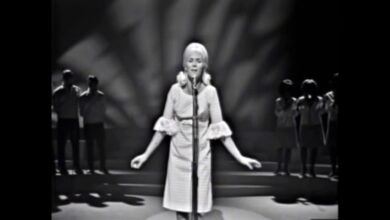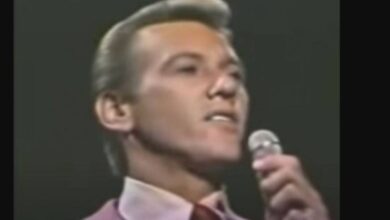Len Barry’s “1-2-3” Blends Soul and Pop to Electrify Charts and Break Barriers in 1965
In the fall of 1965, American radio lit up with a song that seemed deceptively simple in both title and structure—“1-2-3” by Len Barry. Yet beneath its catchy countdown lay a masterclass in soul-infused pop, a track that would climb to No. 2 on the Billboard Hot 100 and No. 3 on the UK Singles Chart. More than just a commercial success, “1-2-3” helped bridge the gap between Black soul music and white pop audiences at a crucial moment in American cultural history. With its bouncy rhythm, heartfelt vocal delivery, and polished production, it stood as one of the most defining records of mid-60s crossover music.
Len Barry, born Leonard Borisoff in Philadelphia in 1942, was no newcomer to music by the time “1-2-3” catapulted him to solo fame. He had previously fronted The Dovells, a vocal group known for their 1961 hit “Bristol Stomp,” which reached the Top 10 in the U.S. With The Dovells, Barry had honed his style on a mix of doo-wop, R&B, and early rock & roll. But his voice—rich, smooth, and filled with emotional immediacy—was the true standout. As a solo act, he carried not only a distinctive vocal signature but a deep appreciation for Black music, which heavily informed his artistic approach.
The inspiration behind “1-2-3” reportedly came from Barry’s love of Motown. Collaborating with John Madara and David White—two Philadelphia-based producers and songwriters who had also worked on hits like “At the Hop”—Barry crafted a song that mirrored the groove and charm of Motown hits, particularly those from The Supremes and The Four Tops. Though Barry himself was white, the songwriting and arrangement of “1-2-3” embraced the melodic elegance and rhythmic urgency of soul music, making it one of the earliest and most successful white-led soul-pop crossover singles of the era.
Recording took place in Philadelphia with a cast of seasoned session players. Barry, who also co-produced the track, ensured that the instrumentation hit the sweet spot between soulful depth and pop clarity. The arrangement featured a steady bassline, upbeat horns, and tight background vocals that added warmth and dynamism to the track. Barry’s lead vocal—pleading yet playful—danced over the melody with a youthful, almost breathless energy. The structure of the song, counting “1-2-3 / Oh, that’s how elementary it’s gonna be,” gave it immediate accessibility, but it was the emotional sincerity in Barry’s delivery that truly connected.
Released in September 1965, “1-2-3” became an instant hit. Within weeks, it raced up the Billboard Hot 100, eventually peaking at No. 2, blocked only by The Supremes’ “I Hear a Symphony.” It also reached No. 11 on the Billboard R&B chart—a rare feat for a white artist performing a song so steeped in soul. Internationally, the track performed exceptionally well, especially in the UK, where it peaked at No. 3 and helped Barry achieve pop stardom abroad. The single sold over one million copies and earned a gold disc, firmly establishing Barry as a major solo act.
Culturally, “1-2-3” played a significant role in softening racial lines within American popular music. At a time when Motown was still fighting for full recognition on pop radio and civil rights tensions were escalating nationwide, Barry’s unabashed embrace of Black musical traditions helped broaden mainstream appreciation for soul. Though controversies emerged regarding the song’s authorship—with Motown’s Holland–Dozier–Holland claiming it was too similar to The Supremes’ “Ask Any Girl”—“1-2-3” ultimately stood as an early example of the mutual musical exchange that defined the decade.
For Len Barry, the song was both a breakthrough and a burden. It launched him into the spotlight, securing TV appearances on shows like American Bandstand and Shindig!, and even led to a UK tour where he shared bills with artists like Dusty Springfield and The Rolling Stones. However, replicating its success proved elusive. While Barry followed up with other singles like “Like a Baby” and “Somewhere,” none matched the massive impact of “1-2-3.” Still, it gave him a platform that lasted well into the decade and opened doors into the UK market and beyond.
The influence of “1-2-3” could be felt in the emerging genre of blue-eyed soul. Alongside contemporaries like The Righteous Brothers and Dusty Springfield, Barry helped lay the groundwork for white artists performing soul music with credibility and emotional authenticity. The track also inspired a generation of artists—including Hall & Oates, who hailed from the same Philadelphia scene—to embrace a soulful vocal approach in pop settings.
Over the years, “1-2-3” has been covered and referenced by multiple artists. The most notable was perhaps Wilson Pickett’s version, which reimagined the track with deeper funk elements. Though not as commercially successful as Barry’s original, Pickett’s version reinforced the song’s roots in soul and gave it added credibility within the R&B community. The track also found renewed life in films, television, and commercials, where its nostalgic charm and simple message remained appealing across generations.
At the time of the song’s release, Barry was also undergoing a period of personal and professional change. Breaking from The Dovells and launching a solo career required immense self-belief, especially at a time when the industry was volatile and racially charged. “1-2-3” affirmed his ability to stand alone, but it also became a weight to carry—his most defining work coming at the very beginning of his solo journey. Still, the pride Barry felt in the track never wavered, and he continued performing it throughout his life.
The legacy of “1-2-3” is one of enduring crossover appeal. Though not always included in the top-tier lists of 60s soul or pop classics, the song retains a firm place in the canon of blue-eyed soul and remains one of the clearest examples of how a simple, well-constructed tune could defy genre expectations and captivate an audience. It continues to receive airplay on oldies stations and is often featured on compilations that highlight the sounds of 1965—a year when the musical boundaries of race, genre, and geography were actively shifting.
From a broader perspective, “1-2-3” helped shape how pop music would evolve in the latter half of the decade. It showed that soul was not just a niche genre, but a vibrant, adaptable style that could thrive in multiple markets. Its vocal-forward production, tight instrumentation, and lyrical accessibility laid a path that many others would follow in combining emotional sincerity with radio-friendly structure.
Though Len Barry never quite repeated the monumental success of “1-2-3,” the song remained the crown jewel of his discography. He continued recording and performing into the 1970s and later found renewed appreciation among Northern Soul collectors and vintage pop enthusiasts. When he passed away in 2020, tributes poured in recognizing not just the man, but the timeless track that had once brought soul to the top of the pop charts.
“1-2-3” endures because it embodies the best of mid-60s pop—a perfect blend of sincerity, rhythm, and charm. For Len Barry, it was the high watermark of a career rooted in passion and performance. For listeners, it remains a joyful reminder of a time when soul and pop danced closer together, counting off something simple and unforgettable, one beat at a time.



